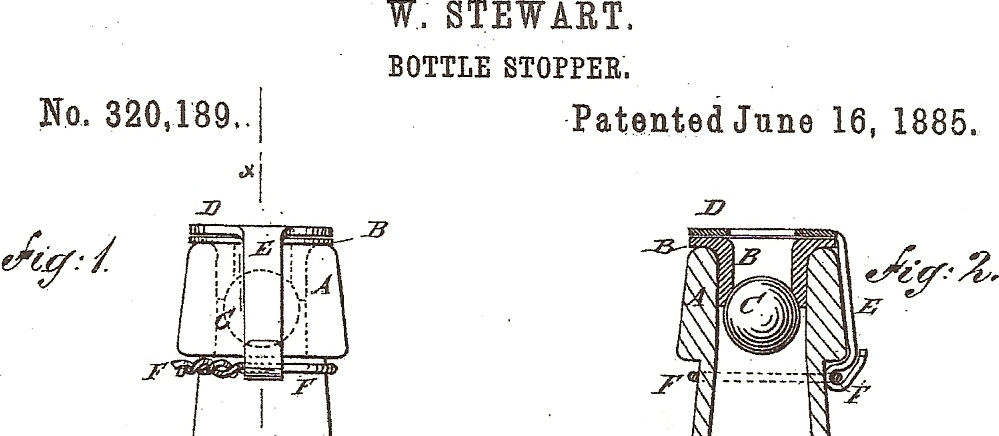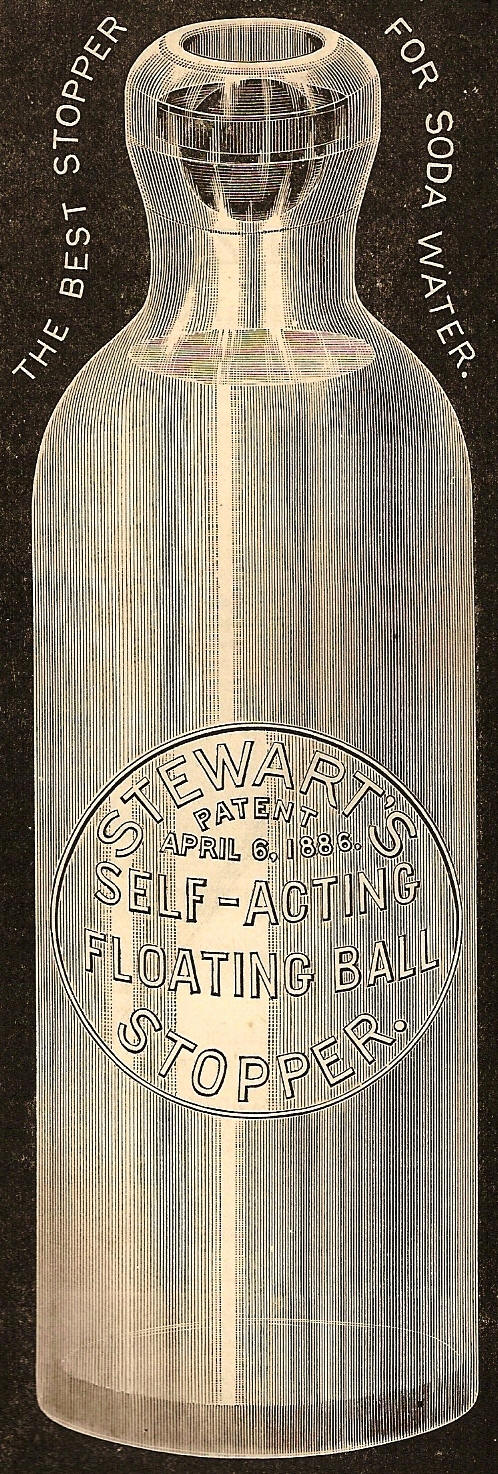William Stewart Bottle Stopper


William Stewart’s
1886 patent application was filed October 19, 1885 and specified:
I, William Stewart…of…Brooklyn…
This invention relates to a new and improved
self-acting internal stopper for bottles containing or intended to
contain soda-water or other liquid charges with gases; and the objects
are to produce a stopper which can be used in any bottle, which will be
buoyant enough to float on the liquid and light enough to be lifted by
the internal pressure to its seat in the neck of the bottle without
requiring a lifting device or the bottle to be tilted or inverted, and
which will not necessitate the use of any special kind of machine for
filling or cleaning the bottle.
Heretofore internal stoppers, usually of a spherical
shape, have been employed, and such stoppers may be divided into two
classes – viz., first, gravitating stoppers, or stoppers of greater
specific gravity than the liquid, and, second, floating stoppers, or
stoppers of less specific gravity than the liquid.
Stoppers of the first class have heretofore consisted of a solid
glass ball or a weighted hollow ball, and in some cases of a flat disk
of pearl, ivory, or glass, and those of the second class of hollow balls
composed of glass, porcelain, or sheet metal, and in some cases of a
flat or nearly flat disk of several layers of cork or pearl or cork and
india-rubber, or a ball composed of elastic material has been employed;
but all such stoppers were objectionable in that they required special
manipulation in filling and cleaning them, and, further, because to
bring the stopper to its seat in the neck of the bottle, after the
latter had been filled, it was necessary to use a lifting device or to
tilt the bottle, so that the stopper would drop into the neck, thus
causing a waste of liquid and gas.
By my invention I seek to produce a stopper which will
obviate all these objections; and to this end my invention consists in a
self-acting internal stopper, preferably composed of hard non-elastic
material – such as vulcanized rubber – and which is buoyant enough to
float on the liquid and light enough to be impelled to and seated
against the packing-ring automatically by the gaseous pressure within
the bottle without extraneous assistance or manipulation…
Figure 1 is a sectional view of an empty bottle
supplied with my improved stopper.
Fig. 2 is a similar view of a bottle filled with the liquid.
Fig. 3 is a section of my improved stopper.
The stopper, a is composed of two semi-spherical
shells, united to form a hollow ball.
I propose to make these stoppers of hard vulcanized rubber, as
this is the only material I have been able to find from which it is
possible to make a practically useful stopper of the requisite buoyancy
and lightness. I have found
by careful practical experiments that is not possible to make a
self-acting stopper from glass, porcelain, sheet metal, or elastic
material, and that while cork is light enough for the purpose it is very
objectionable, because it will rot, and thus render the stopper useless
in a short time.
A stopper of elastic material, as heretofore made, is
not light enough to be self-acting to close the bottle when the bottle
is in the usual upright position during the filling process, and is too
buoyant to roll into the neck to close the mouth of the bottle when it
is inverted…(and)…unless they are of greater diameter than the inside
diameter of the neck of the bottle they are liable to be blown out of
the bottle by the internal pressure…
Stoppers composed of glass, porcelain, or sheet metal,
besides not being self-acting, are objectionable, because of the
liability of breakage of the bottle or the stopper during the washing,
filling, or emptying of the bottle, and, further, because they require a
bottle of special construction to prevent the stopper from rolling back
to its seat in the neck when the liquid is being poured out…
A floating stopper composed of a flat or nearly flat
disk is objectionable, in that it is difficult to get such a stopper
properly seated, as it requires a special construction of the neck of
the bottle to make a gas-tight joint.
In Figs. 1 and 2 of the drawings I have shown my
improved stopper in connection with a bottle supplied with a cap of the
construction described and claimed in…Letters Patent No. 320,189,
granted to me June 16, 1885…

In these (1886) figures of the drawings,
a designates the stopper,
b a soft packing, and
c a metal cap.
The packing is ring shaped, and is laid over the edge of the
mouth of the bottle, and held there by the cap, which has a central
aperture, d.
This cap is provided with arms which are bent around a fastening
wire, e, which encircles the bottle neck.
The bottle itself is of ordinary construction, and the stopper of
less diameter than the inside diameter of the neck.
When the bottle is filled, the stopper
a rises to the surface of the
liquid, and is then lifted by the internal pressure to its seat against
the packing, thus closing the bottle.
When the liquid is to be poured out, the stopper is pushed from
its seat by means of a rod or other suitable implement, and rises
through the liquid to the highest part of the bottle, when the latter is
tilted or inverted to discharge its contents.
My improved stopper, with a
ring-shaped packing and aperture cap, can be applied to any bottle, and
the bottle can be filled by any ordinary bottling-machine in the market,
thus enabling a bottler of soda-water or other liquids charged with gas
to utilize bottles which are now practically useless, resulting in a
saving to the bottling trade of many thousand dollars every year.
Comments:
William Stewart’s patent specifications outline many
of the challenges bottlers and customers faced, and in combination with
the illustrations provide a fairly easy-to-understand description of his
stopper’s design and how it functioned.
Once the patent was approved, a Stewart Bottle Stopper Company
advertisement in an 1886 issue of the
National Bottlers’ Gazette
proclaimed:
THE STEWART PATENT SELF-ACTING SODA WATER STOPPER IT
BEATS THEM ALL.
The Self-Acting Floating Ball Stopper is a light,
hollow ball, a mere shell, but strong enough to bear the weight of a man
and hard enough to withstand the action of acids.
It is, therefore, impervious and will not contaminate the
beverage…
DIRECTIONS TO FILL – To fill these bottles you simply
place it right end up, like you would fill a bottle with a cork, and
place a cork in the cylinder, and instead of driving it you leave it
remain, to prevent the flow of water up through the cylinder.
That is all there is to it.
It is just as easy and as simple as rolling off a log.
See the point? When
you desire to open a bottle, when it is freshly bottled, with the foam
filling the neck, use an opener to force the ball to the liquid.
After the foam has subsided, you can drop the ball to the liquid
by one quick motion of the forefinger.
Bottles utilizing Stewart’s 1885 patent stopper are
known, but we’ve yet to see an example matching the Self-Acting Floating
Ball Stopper bottle as illustrated and described in his 1886 patent.
Historical research has yet to fill a major gap in this story, as
there certainly appears to have been an as-yet-to-be-determined business
relationship between William Stewart, Selden Twitchell (of the Twitchell
Bottle Stopper Company of Philadelphia, Pennsylvania), and William
Roorbach.
In 1885 the Twitchell Bottle Stopper Company was
advertising “Twitchell’s Self-Acting Floating Ball Stopper.”
Less than a year later, an identical closure was being marketed
by the Stewart Bottle Stopper Company of


The floating-ball stoppers promoted by Twitchell,
Stewart, and Roorbach achieved limited marketing success with bottlers
across
TWITCHELL’S Patent Floating
Ball STOPPERS
IS THE BEST IN EVERY WAY FOR
BOTTLING CARBONATED BEVERAGES.
1 – It can be
filled and
stoppered with any
Bottling Machine, hence no expense in adopting it.
2 – It is filled and stoppered
quicker than
cork or any other patent stopper.
3 – It has
no metal about it to contaminate beverages with
metal poisons.
4 – It has
no soft rubber to come in contact with or to contaminate
the beverages with obnoxious flavors or odors as with all other patented
stoppers.
5 – All
parts of this stoppered bottle can be washed
quickly and
thoroughly
with brush, shot or any bottle-washing machine.
6 – It has
no protruding stopper to be knocked down by placing
filled cases on top of each other, therefore much more safe.
7 – It is more quickly opened than any other stoppered
bottle, and as the ball quickly leaves the mouth when opened, there
being no obstruction in the mouth of the bottle, the beverage flows out
quickly, without any agitation at the expense and loss of carbonic gas.
8 – This bottle has
no crevices or
irregularities about it to prevent its
thorough
cleansing in every part.
9 – No flies or dirt can get into the bottle after
being emptied, to rot and breed maggots, if, after being washed and
drained, it be placed in box or case, mouth downward, as the ball drops
to the mouth and prevents flies or dirt from getting into it.
10 – It cannot be used for
spirituous liquors
of any kind, nor for root
beer or
ketchup.
11 – When properly filled about to the shoulder, even
though frozen solid, the bottle will not break if thawed out in cool
water.
12 – The bottles for our Patent Stopper can be made in
private moulds that are used for making bottles for cork or any of the
metal spring stoppers, by enlarging the part of the moulds that forms
the neck of the bottles.
13 – Our Patent Floating Stopper is of such shape and
material as to withstand all wear without being broken; hence there are
no repairs or replacing of parts at considerable expense and labor, as
this is with all
other patent stoppers for same purposes.
14 – Our Patent Floating Stopper is so little affected
by wear that it will outlast one hundred of the metal spring style of
stoppers.
We supply Special “Finishing Tools” so any Glass
Factory can make Perfect Bottles
Price of Twitchell’s Floating Ball Stoppers, Fittings
Complete, $2.25 per Gross.
Our Hard Rubber Floating Ball Stopper, $1.25 per gross.
Our Patent Rubber Bushing, $1 per gross.
The Twitchell Bottle Stopper
Co.,
 HutchBook.com
HutchBook.com